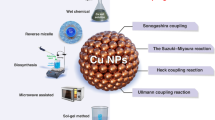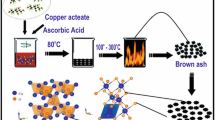Abstract
Tetraazamacrocycle such as 1,4,7,10-tetraazacyclododecane “cyclen” are known for efficient complexation of metallic ions and were used as an ionic recognition agents in chemical sensors in aqueous medium.The aim of this paper is to examine in more detail the oxidation mechanism of amines in cyclen before copper complexation and after copper complexation. Gold electrodes modified with mono-N-MNCyclen(mono methyl-naphtyl-cyclen) and tetra-N-MNCyclen thin films were obtained by deposition of mono-N-MNCyclen and the tetra-N-MNCyclensynthesized respectively by bisaminal route in three steps (protection, N-mono-alkylation and deprotection) and direct route. The comparative study of the electrochemical oxidation of amines in both cyclens allowed the identification of the tertiary and of the secondary amines. From the potential-pH relation and the variation of the intensities of the oxidation peaks, the redox mechanisms of both types of amines was proposed. The electrochemical redox behaviour of the amines in the copper-mono-N-MNCyclen complex was studied. From the potential-pH relation and the variation of the intensities of the oxidation peaks, the redox mechanisms of amines and the structure of the copper-mono-N-MNCyclen complex were proposed. The intensities of the oxidation peaks of the amines vary linearly with the copper concentration, in the range 10−12 M to 10–6 M, leading to a detection limit of of 1 pM of Cu2+.

















Similar content being viewed by others
References
S. Martin, W. Griswold, Human Health Effects of Heavy Metals. Environmental Science and Technology Briefs for Citizens, CHSR, Kansas State University Issue 5, March 2009.
R.A. Mohamed, A.M. Abdel-Lateef, H.H. Mahmoud, A.I. Helal, Determination of trace elements in water and sediment samples from Ismaelia Canal using ion chromatography and atomic absorption spectroscopy. Chem. Speciat. Bioavailab 24, 31–38 (2012). https://doi.org/10.3184/095422912X13257005726800
O.V.S. Raju, P.M.N. Prasad, V. Varalakshmi, Y.V.R. Reddy, Determination of heavy metals in ground water by ICP-OES in selected coastal area of Spsr Nellore District, Andhra Pradesh. India. Int. J. Innov. Res. Sci. Eng. Technol. 3, 9743–9749 (2014)
M. Batsala, B. Chandu, B. Sakala, S. Nama, S. Domatoti, Inductively coupled plasma mass spectrometry (ICP-MS). Int. J. Res. Pharm. Chem. 2(3), 671–680 (2012)
X. Yu, J. Zhang, Macrocyclic Polyamines: Synthesis and Applications (Wiley, New York, 2018).
W.B. Mefteh, H. Touzi, Y. Chevalier, H.B. Ouada, A. Othmane, R. Kalfat, N. Jaffrezic-Renault, Comparison of polysiloxane films substituted by undecenyl-cyclam and by naphthyl-cyclam for the design of ISFET devices sensitive to Fe3+ions. Sens. Actuators B 204, 723–733 (2014). https://doi.org/10.1016/j.snb.2014.07.129
W.B. Mefteh, H. Touzi, Y. Chevalier, F. Bessueille, R. Kalfat, N. Jaffrezic-Renault, Gold electrodes functionalized by methyl-naphthyl substituted cyclam films for the detection of metal ions. Sens. Actuators B 213, 334–342 (2015). https://doi.org/10.1016/j.snb.2015.02.109
H. Touzi, Y. Chevalier, F. Bessueille, H.B. Ouada, N. Jaffrezic-Renault, Detection of dyestuffs with an impedimetric sensor based on Cu2+-methylnaphthylcyclen complex functionalized gold electrodes. Sens. Actuators B 273, 1211–1221 (2018). https://doi.org/10.1016/j.snb.2018.07.011
V. Alexander, Design and synthesis of macrocyclic ligands and their complexes of lanthanides and actinides. Chem. Rev. 95(2), 273–342 (1995). https://doi.org/10.1021/cr00034a002
P. Caravan, J.J. Ellison, T.J. McMurry, R.B. Lauffer, Gadolinium(III) chelates as MRI contrast agents: structure, dynamics, and applications. Chem. Rev. 99(9), 2293–2352 (1999). https://doi.org/10.1021/cr980440x
M.D. Bartholomä, Recent developments in the design of bifunctional chelators for metal-based radiopharmaceuticals used in positron emission tomography. Inorg. Chim. Acta 389, 36–51 (2012). https://doi.org/10.1016/j.ica.2012.01.061
D. Gaffney, N.H. Abdallah, J.C. Cooney, F.R. Laffir, K.E. Cassimpee, P. Berglund, U. Hanefeld, E. Magner, Preparation and characterisation of a Ni2+/Co2+-cyclam modified mesoporous cellular foam for the specific immobilisation of His6-alanine racemase. J. Mol. Catal. B 109, 154–160 (2014). https://doi.org/10.1016/j.molcatb.2014.08.011
S. El Ghachtouli, C. Cadiou, I. Déchamps-Olivier, F. Chuburu, M. Aplincourt, V. Patinec, M. Le Baccon, H. Handel, T. Roisnel, Nickel(II) complexes of cyclen- and cyclam-pyridine: topological reorganisations induced by electron transfer. New J. Chem. 30, 392–398 (2006). https://doi.org/10.1039/b515107d
S. El Ghachtouli, C. Cadiou, I. Déchamps-Olivier, F. Chuburu, M. Aplincourt, T. Roisnel, (Cyclen– and cyclam pyridine)copper complexes: the role of the pyridine moiety in CuII and CuI stabilisation. Eur. J. Inorg. Chem. (2006). https://doi.org/10.1002/ejic.200600297
E. Kimura, T. Gotoh, S. Aoki, M. Shiro, Study of pH-dependent zinc(II)-carboxamide interactions by Zinc(II)-carboxamide-appended cyclen complexes (Cyclen = 1,4,7,10-Tetraazacyclododecane). Inorg. Chem. 41, 3239–3248 (2002). https://doi.org/10.1021/ic020087k
C.B. Castellani, L. Fabbrizzi, M. Licchelli, A. Perotti, A. Poggi, Stabilisation by a strongly acidic medium of trivalent copper tetra-aza macrocyclic complexes. J. Chem. Soc. Chem. Commun. (1984). https://doi.org/10.1039/c39840000806
D.C. Olson, J. Vasilevskis, Cyclic amine complexes of copper(I), -(II), and –(III). Electrochemistry, preparation, and properties. Inorg. Chem. 10(3), 463–470 (1971). https://doi.org/10.1021/ic50097a005
E.K. Barefield, M.T. Mocella, Mechanism of base promoted reduction of nickel(III) complexes of macrocyclic amines. A coordinated ligand radical intermediate. J. Am. Chem. Soc. 97(15), 4238–4246 (1975). https://doi.org/10.1021/ja00848a015
E. Zeigerson, G. Ginzburg, D. Meyerstein, L.J. Kirschenbaum, Comparative study of the electrochemical and pulse-radiolytic oxidation of the complexes of nickel(II) and copper(II) containing 1,4,8,11–tetraazacyclotetradecane. J. C. S. Dalton (1980). https://doi.org/10.1039/dt9800001243
F. Wudl, R.O. Angus Jr., F.L. Lu, P.M. Allemand, D. Vachon, M. Nowak, Z.X. Liu, H. Schaffer, A.J. Heeger, Poly-p-phenyleneamineimine : synthesis and comparison to polyaniline. J. Am. Chem. Soc. 109(12), 3677–3684 (1987). https://doi.org/10.1021/ja00246a026
J. Yue, A.J. Epstein, Synthesis of self-doped conducting polyaniline. J. Am. Chem. Soc. 112(7), 2800–2801 (1990). https://doi.org/10.1021/ja00163a051
A. Deronzier, J.C. Moutet, Functionalized polypyrroles. New molecular materials for electrocatalysis and related applications. Acc. Chem. Res. 22, 249–255 (1989). https://doi.org/10.1021/ar00163a004
E.M. Geniès, A. Boyle, M. Lapkowski, C. Tsintavis, Polyaniline: a historical survey author links open overlay panel. Synth. Met. 36(2), 139–182 (1990). https://doi.org/10.1016/0379-6779(90)90050-U
C.K. Mann, K.K. Barnes, Electrochemical Reactions in Nonaqueous Systems (Marcel Dekker, New York, 1970).
L.C. Portis, V.V. Bhat, C.K. Mann, Electrochemical dealkylation of aliphatic tertiary and secondary amines. J. Org. Chem. 35, 2175–2178 (1970). https://doi.org/10.1021/jo00832a014
S.F. Nelsen, C.R. Kessel, 9-Butylazabicyclo[3.3.1]nonane radical cation, the first long-lived saturated amine radical cation. J. Chem. Soc. Chem. Commun. (1977). https://doi.org/10.1039/c39770000490
H. Bock, I. Goebel, Z. Havlas, S. Liedle, H. Oberhammer, Triisopropylamine: a sterically overcrowded molecule with a flattened nc3 pyramid and a “p-Type” nitrogen electron pair. Angew. Chem. 30, 187–190 (1991). https://doi.org/10.1002/anie.199101871
T.M. McKinney, D.H. Geske, The triethylenediamine cation radical. J. Am. Chem. Soc. 87(13), 3013–3014 (1965). https://doi.org/10.1021/ja01091a044
P.A. Bischoff, J.A. Hasmall, E. Heilbronner, V. Hornung, Nitrogen lone pair interaction in 1,4-diaza-bicyclo[2.2.2]octane (DABCO). Tetrahedron Lett. 10(46), 4025–4028 (1969). https://doi.org/10.1016/S0040-4039(01)88604-4
E. Heilbronner, K.A. Muszkat, Applications of photoelectron spectroscopy. X. Relative importance of through-space vs. through-bond interaction between the lone pairs in 1,4-diazabicyclo[2.2.2]octane. J. Am. Chem. Soc. 92(12), 3818–3821 (1970). https://doi.org/10.1021/ja00715a064
S.F. Nelsen, J.M. Buschek, Charge delocalization in saturated systems. The radical cation of 1,3,6,8-tetraazatricyclo[4.4.1.13,8]dodecane. J. Am. Chem. Soc. 96, 6424–6428 (1974). https://doi.org/10.1021/ja00827a028
S.F. Nelsen, E. Haselbach, R. Gschwind, U. Klemm, S. Lanyova, Three-electron, sigma, bonding in the radical cation from 1,3,6,8-tetraazatricyclo [4.4.1.13,8]dodecane. J. Am. Chem. Soc. 100, 4367–4368 (1978). https://doi.org/10.1021/ja00482a008
R.W. Alder, R. Gill, N.C. Goode, Formation of three- and two-electron σ-bonds by removal of lone pair electrons from a diamine. J. Chem. Soc. Chem. Commun. (1976). https://doi.org/10.1039/C39760000973
R.W. Alder, N.C. Goode, T.J. King, J.M. Mellow, B.W. Miller, A 1,5-diazabicyclo[3.3.3]undecane derivative with almost planar bridgehead nitrogens. J. Chem. Soc. Chem. Commun. (1976). https://doi.org/10.1039/c39760000173
Y.L. Chow, W.C. Danen, S.F. Nelsen, D.H. Rosenblatt, Nonaromatic aminium radicals. Chem. Rev. 78(3), 243–274 (1978). https://doi.org/10.1021/cr60313a003
F. Oukhatar, M. Beyler, R. Tripier, Straight forward and mild deprotection methods of N-mono- and N1, N7-functionalised bisaminal cyclens. Tetrahedron 71, 3857–3862 (2015). https://doi.org/10.1016/j.tet.2015.04.021
S.J. Jenkins, Aromatic adsorption on metals via first-principles density functional theory. Proc. Roy. Soc. A 465, 2949–2976 (2009). https://doi.org/10.1098/rspa.2009.0119
C.C. Busby, J.A. Creighton, Efficient gold and silver electrodes for surface enhanced Raman spectral studies of electrochemical systems: the behaviour of pyridine and naphthalene adsorbed on roughened gold electrodes. J. Electroanal. Chem. 140, 379–390 (1982). https://doi.org/10.1016/0022-0728(82)85180-2
T.K. Venkatachalam, J. Barreto, U. Kreher, D.C. Reutens, L. Spiccia, Synthesis, characterization and coordination chemistry of dibenzofuran derivaties of 1,4,7,10-tetraazacyclododecane. Inorg. Chim. Acta 363, 2896–2904 (2010). https://doi.org/10.1016/j.ica.2010.04.039
A. Adenier, M.M. Chehimi, I. Gallardo, J. Pinson, N. Vilà, Electrochemical oxidation of aliphatic amines and their attachment to carbon and metals surfaces. Langmuir 20, 8243–8253 (2004). https://doi.org/10.1021/la049194c
B.F. Liang, C.S. Chung, Dissociation and isomerization kinetics of (meso-5,5,7,12,12,14-Hexamethyl-1,4,8,11-tetraazacyclotetradecane)copper(II) (Blue) cation in strongly acidic, aqueous media. Inorg. Chem. 20, 2152–2155 (1981). https://doi.org/10.1021/ic50221a040
R.W. Hay, M.P. Pujari, The dissociation of [Cu(cyclen)]2+ in acid solution. A kinetic study. Inorg. Chim. Acta 100, L1–L3 (1985). https://doi.org/10.1016/S0020-1693(00)85272-X
A.P. Leugger, L. Hertli, T.A. Kaden, Metal complexes with macrocyclic ligands. XI1). ring size effect on the complexation rates with transition metal ions. Helv. Chim. Acta 61, 2296–2306 (1978). https://doi.org/10.1002/hlca.19780610703
P. Schultz-Grunow, T.A. Kaden, Metal complexes with macrocyclic ligands X1). on the metal complexation kinetics of two N4-macrocycles containing a pyridine ring. Helv. Chim. Acta 61, 2291–2296 (1978). https://doi.org/10.1002/hlca.19780610702
A. Bianchi, M. Micheloni, P. Paoletti, Thermodynamic aspects of the polyazacycloalkane complexes with cations and anions. Coord. Chem. Rev. 110, 17–113 (1991). https://doi.org/10.1016/0010-8545(91)80023-7
M. Kodama, E. Kimura, Thermodynamic and kinetic effects of 13-membered macrocycles. Polarographic studies of 1,4,7,10-tetra-azacyclotridecanecopper (II) . J.C.S Dalton Trans 2, 1720–1724 (1976). https://doi.org/10.1039/dt9760001720
Funding
The authors thank CNRS and DGRST for their financial support through PICS 2017-2020 # 226221.
Author information
Authors and Affiliations
Corresponding author
Additional information
Publisher's Note
Springer Nature remains neutral with regard to jurisdictional claims in published maps and institutional affiliations.
Rights and permissions
About this article
Cite this article
Touzi, H., Haj Said, A., Chevalier, Y. et al. Effect of Copper on the Oxidation Mechanisms of Tertiary and Secondary Amines of Methyl-naphthyl- cyclen-Modified Gold Electrodes. J Inorg Organomet Polym 31, 3011–3026 (2021). https://doi.org/10.1007/s10904-020-01864-4
Received:
Accepted:
Published:
Issue Date:
DOI: https://doi.org/10.1007/s10904-020-01864-4




